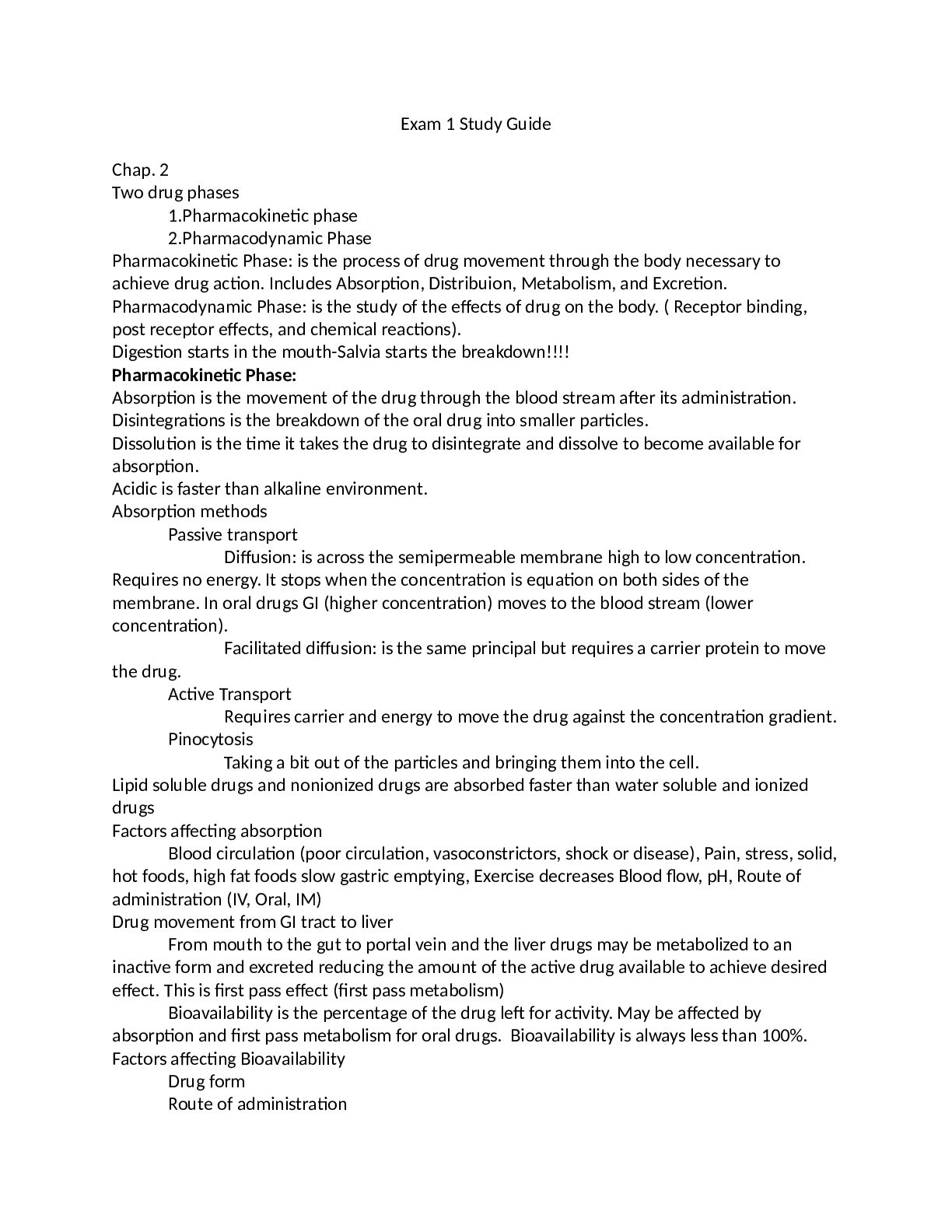Two drug phases1.Pharmacokinetic phase2.Pharmacodynamic Phase
Pharmacokinetic Phase: is the process of drug movement through the body nachieve drug action. Includes Absorption, Distribuion, Metabolism, and ExcretiPharmacodynamic Phase: is the study of the effects of drug on the body. ( Recpost receptor effects, and chemical reactions).
Digestion starts in the mouth-Salvia starts the breakdown!!!!
Pharmacokinetic Phase:Absorption is the movement of the drug through the blood stream after its adDisintegrations is the breakdown of the oral drug into smaller particles.
Dissolution is the time it takes the drug to disintegrate and dissolve to becomabsorption. Acidic is faster than alkaline environment.
Absorption methodsPassive transportDiffusion: is across the semipermeable membrane high to low Requires no energy. It stops when the concentration is equation on both sides membrane. In oral drugs GI (higher concentration) moves to the blood stream concentration). Facilitated diffusion: is the same principal but requires a carrithe drug.
Active TransportRequires carrier and energy to move the drug against the concPinocytosisTaking a bit out of the particles and bringing them into the cellLipid soluble drugs and nonionized drugs are absorbed faster than water soludrugs
Factors affecting absorptionBlood circulation (poor circulation, vasoconstrictors, shock or disease)hot foods, high fat foods slow gastric emptying, Exercise decreases Blood flowadministration (IV, Oral, IM)Drug movement from GI tract to liverFrom mouth to the gut to portal vein and the liver drugs may be metainactive form and excreted reducing the amount of the active drug available teffect. This is first pass effect (first pass metabolism)Bioavailability is the percentage of the drug left for activity. May be affabsorption and first pass metabolism for oral drugs. Bioavailability is always lFactors affecting BioavailabilityDrug formRoute of administrationGastric mucosa and motility
Administration w/food and other drugsChanges in liver metabolism
Drug distribution: is the movement of the drug form the circulation to tissuesProtein binding ( highly and weakly protein bound drugs)Drugs drugs( unbound)Volume of drug distributionCompetition over protein binding sites leads to more free drug
Low plasma protein levels causes more free drugs floating aroundLow albumin same thing (elderly considerations)BBB (blood brain barrier)Water soluble drugs do not cross the BBB
You want to be careful with those who are pregnant some drugs cross the pladamageDrug metabolism (biotransformation: changing the drug chemically to form thexcretion)Half life: from administration to reduction of the drug in the body to a previous dose, metabolism, and elimination.
Ex. Ibuprofen= 2hr 6am
200mg in two hrs= 100mg 8am100mg in 2 hrs= 50mg 10am50mg in 2hrs= 25mg 12pm25mg in two hrs=12.5mg 2pm12.5mg in 2 hrs= 6.25mg 4pmSteady state=plateau=amount administered= amount eliminated usua5
th half life if given consistently
Loading dose= large initial dose of medication (seizure medications) smfollow consistent time intervals.
Drug excretion (elimination)
KidneysCreatinine clearanceBUNGlomerular filtration rate lower in older and female due to decmassUrine pH 4.6-8Liver (bile)FecesLungsSaliva, sweat, breast milkPharmacodynamics Phase:
Primary effect-desirable responseSecondary effect- desirable or undesirable response
Ex. Benadryl (primary effect= treatment of allergies, Secondary depression (sedation)) Drug response relationshipPotency: the amount of drug needed to elicit specific physiological resPhysiological response at very low concentration=low potencyTherapeutic index Onset: time it takes for drug to reach minimum effective concentration
Peak: highest concentration in blood
Duration: length of time taken for drug to exert a therapeutic effect
Below therapeutic response= under dose making it ineffective
Above therapeutic response= overdosed maybe toxic
Therapeutic drug monitoring
Peak drug level: highest plasma concentration of drug
Trough drug level: lowest plasma concentration of the drug.
Receptor theoryDrugs bind to receptors
To activate receptors To produce a responseTo inactivate a receptor
Drugs can compete for the same receptor site. If one is bound the other one iFour receptor familiesCell membrane-imbedded enzymesLigand-gated ion channelsg-protein-coupled receptor systemstranscription factors AgonistsActivate receptors Produce desired response
Pushers/stimulators Antagonists
Prevent receptor activation
Block response Preventors/ stimulators Nonspecific: multiple receptor sites
Nonselective: works on multiple receptors
Cholinergic receptors: eye, heart, blood vessels, stomach, bronchus, and bladMechanisms of drug actionStimulationDepressionIrritationReplacementCytotoxic actionAntimicrobial actionModification of immune statusSide effects
Secondary effects
Read More


